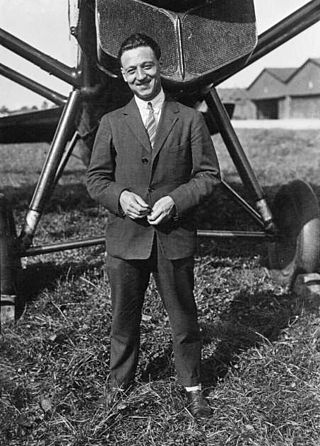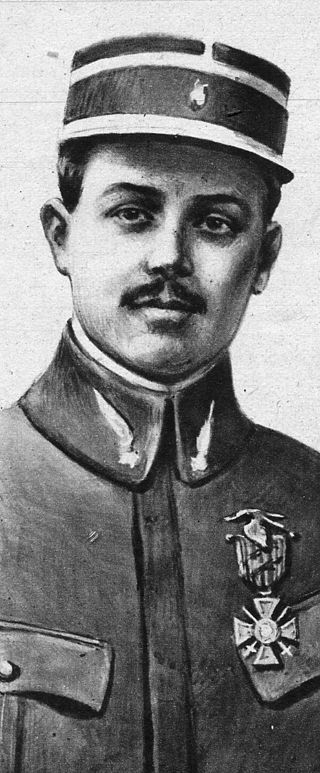Related Research Articles

The Royal Flying Corps (RFC) was the air arm of the British Army before and during the First World War until it merged with the Royal Naval Air Service on 1 April 1918 to form the Royal Air Force. During the early part of the war, the RFC supported the British Army by artillery co-operation and photographic reconnaissance. This work gradually led RFC pilots into aerial battles with German pilots and later in the war included the strafing of enemy infantry and emplacements, the bombing of German military airfields and later the strategic bombing of German industrial and transport facilities.
Hans Kirschstein, winner of the Pour le Merite, Royal House Order of Hohenzollern, and the Iron Cross, 1st and 2nd class, was a German lieutenant and World War I flying ace credited with 27 aerial victories.
Sous Lieutenant Marius René Marie Hasdenteufel (1894–1918) was a French World War I flying ace credited with five confirmed and two probable aerial victories.

Lionel Alexandre Pierre de Marmier was a World War I flying ace credited with six confirmed aerial victories in World War I. He remained involved in aviation postwar, setting flying records and serving in the Spanish Civil War. At the start of World War II, he returned to his nation's service, shooting down at least one German plane. He died in an air crash on 30 December 1944. He was posthumously promoted to General.

Captain-Commandant Fernand Maximillian Leon Jacquet was a World War I flying ace credited with seven aerial victories. He was the first Belgian pilot to score an aerial victory, on 17 April 1915, and became the first Belgian ace on 1 February 1917. He was also the first Belgian pilot to fly the Belgian king Albert I to the front, in 1917. Additionally, he was the only Belgian honored by the British with a Distinguished Flying Cross.

Lieutenant Jean Augustin Paul Joseph Loste was a French World War I flying ace credited with seven aerial victories. He remained in service after World War I ended, finally retiring in 1930 at the rank of Chef de Bataillon.
CapitaineGabriel Joseph Thomas was a World War I flying ace credited with seven aerial victories.
Lieutenant Eugène Weismann (1896–1973) joined the infantry on 28 September 1914 and suffered frostbite and three wounds before transferring to aerial service in 1917. The loss of a foot to a grenade did not prevent him from becoming an aerial gunner and a flying ace with seven confirmed aerial victories. Weismann was one of five notable Jewish aces. He also received citations in World War II.

OberleutnantAlexander Tahy was a Hungarian World War I flying ace credited with eight aerial victories while serving with the Austro-Hungarian Aviation Troops. He began the war as an artilleryman, winning the Silver Medal for Bravery in May 1915. In early 1916, he transferred to aviation duty as an aerial observer. Between 3 December 1916 and 26 June 1917, he was credited with five aerial victories for Fliegerkompanie 19, earning another three decorations. Having taught himself to fly, he transferred to a fighter unit, Fliegerkompanie 51J for his last three victories. On 7 March 1918, Tahy died in a flying accident. His greatest honor came after his death, when he was awarded the Knight's Cross of the Order of Leopold with War Decorations and Swords.
Sous lieutenantAndré-Henri Martenot de Cordou was a French World War I flying ace credited with eight aerial victories.

Lieutenant Jean Chaput was a French World War I flying ace credited with 16 aerial victories.

Capitaine Albert Louis Deullin was a French World War I flying ace credited with twenty aerial victories. He served for the entirety of World War I. By war's end, he had risen to command of a fighter wing. He would die in a postwar flying accident.
Sous Lieutenant Fernand Eugene Guyou was a World War I flying ace credited with twelve aerial victories.
Major Adrien Louis Jacques Leps was a French World War I flying ace credited with twelve confirmed aerial victories, as well as two probables. He served originally in the cavalry, before shifting to flying. In later years, he served under General Armand Pinsard during World War II.
Lieutenant Colonel Charles Marie Joseph Leon Nuville LH was a French World War I flying ace credited with twelve confirmed aerial victories. He served as a professional soldier throughout the interwar years, and through World War II.
Sous Lieutenant William Louis Max Herisson was a French flying ace during World War I. He was credited with eleven confirmed aerial victories.

Sous lieutenant Louis Prosper Gros became a flying ace during World War I, scoring eight confirmed aerial victories, and possibly a ninth. He continued in aviation after the war, and defended his nation again during World War II.
Lieutenant Julien Anatole Guertiau was a cavalryman turned aviator who became a flying ace during World War I. He was credited with eight aerial victories.
Sous lieutenant Antoine Cordonnier was a French flying ace during World War I. He was credited with five aerial victories.
Paul Georges Alexandre Rodde was a French World War I flying ace credited with five confirmed aerial victories.
References
- 1 2 Norman, Franks (1992). Over the Front: The Complete Record of the Fighter Aces and Units of the United States and French Air Services, 1914–1918. pp. 136–137.
- ↑ "Fonds Louis Fernand Coudouret (1896–1929), pilot, corporal in the VB 102 squadron, sergeant in the N 57 squadron, warrant officer". Archives Nationales (France) . Retrieved 2 August 2020.
- ↑ Saunders, Minot (20 April 2008). "Atlantic Still Holds Lure for Bevy of French Fliers". Chattanooga News . Chattanooga . Retrieved 2 August 2020– via Newspapers.com.
- ↑ "Crash of a Bernard 191gr Near Angouleme: 1 Killed". Bureau of Aircraft Accidents Archives (B3A).